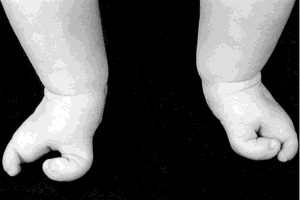ectrodactyly
[ek″tro-dak´tĭ-le]congenital absence of all or part of a digit.

Appearance of the feet in a child with ectrodactyly. From Muller and Young, 2001.
Miller-Keane Encyclopedia and Dictionary of Medicine, Nursing, and Allied Health, Seventh Edition. © 2003 by Saunders, an imprint of Elsevier, Inc. All rights reserved.
ec·tro·dac·ty·ly
, ectrodactyliaectrodactylism (ek'trō-dak'ti-lē, -dak-til'i-ă, -dak'ti-lizm), [MIM*225300]Congenital absence of all or part of one or more fingers or toes. There are several varieties and the pattern of inheritance may be autosomal dominant with reduced penetrance [MIM*183600 and MIM*183802], autosomal recessive [MIM*225290 and MIM*225300], or X-linked [MIM*313350].
[ectro- + G. daktylos, finger]
Farlex Partner Medical Dictionary © Farlex 2012
ectrodactyly
A nonspecific term applied to a variety of malformations, but which probably best reserved for transverse terminal aphalangia, adactylia or acheiria.Segen's Medical Dictionary. © 2012 Farlex, Inc. All rights reserved.
ec·tro·dac·ty·ly
, ectrodactylia , ectrodactylism (ek'trō-dak'ti-lē, -dak-til'ē-ă, -dak'ti-lizm)Congenital absence of all or part of one or more fingers or toes. Known also as split-hand/foot deformity, lobster claw. There are several varieties and the pattern of inheritance is usually irregular.
[ectro- + G. daktylos, finger]
Medical Dictionary for the Health Professions and Nursing © Farlex 2012